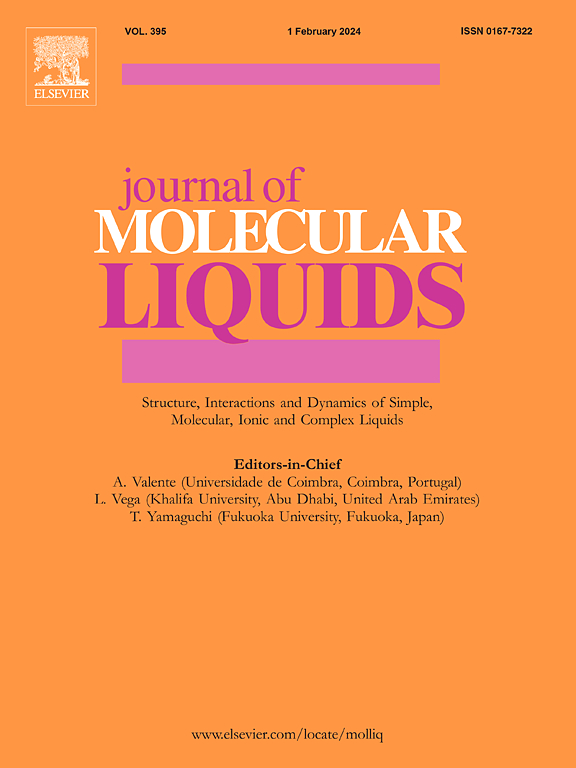用于水检测的萘酰亚胺和萘酸酐荧光探针:分子结构和光物理
IF 5.3
2区 化学
Q2 CHEMISTRY, PHYSICAL
引用次数: 0
摘要
本文结合光物理和理论分析对四种萘酰亚胺和萘酸酐衍生物的分子结构进行了全面的研究。这些化合物在绿色范围内表现出很强的发射带,这取决于溶剂的极性。加水后,随着水位的升高,绿色发射强度明显降低,同时发射波段出现红移。在DMF中水含量为0 ~ 40%的范围内,样品对水存在的敏感性随绿色排放强度的降低而变化在45% ~ 60%之间。并根据辐射强度的变化估计了水的检出限。分析了其在不同有机溶剂/水混合物中的光物理行为。利用密度泛函理论(DFT)对优化后的分子几何形状、电子结构、极化率、原子电荷、静电势和前沿分子轨道进行了研究。利用时间依赖密度泛函理论(TD-DFT)计算了萘酰亚胺和萘酸酐的理论紫外可见光谱。计算结果显示,从基态到第一激发态(S0 S1)的垂直电子跃迁是归属于HOMO LUMO轨道构型的π-π*型跃迁。本文章由计算机程序翻译,如有差异,请以英文原文为准。
Naphthalimide and naphthalic anhydride fluorescent probes for water detection: Molecular structure and photophysics
Herein, a comprehensive investigation combining photophysics and theoretical analysis of molecular structures of four naphthalimide and naphthalic anhydride derivatives has been reported. These compounds present a strong emission band in the green range, which depends on the solvent polarity. Upon the water addition, a pronounced decrease in the green emission intensity was observed accompanied by a red shift of the emission band as the water level increased. The sensitivity to water presence for samples under study in the range of 0–40 % water in DMF varied between 45 and 60 % relating to the decrease of the green emission intensity. Also, the limit of detection for water was estimated based on the emission intensity changes. The photophysical behavior was analyzed in different organic solvent/water mixtures. The optimized molecular geometries, electronic structures, polarizabilities, atomic charges, electrostatic potentials, and frontier molecular orbitals were explored using density functional theory (DFT). Theoretical UV–Vis spectra of naphthalimide and naphthalic anhydride compounds were computed using time-dependent density functional theory (TD-DFT). Computational results revealed that the vertical electronic transition from the ground state to the first excited state (S0➔S1) was of π-π* type transition assigned to the HOMO➔LUMO orbital configuration.
求助全文
通过发布文献求助,成功后即可免费获取论文全文。
去求助
来源期刊

Journal of Molecular Liquids
化学-物理:原子、分子和化学物理
CiteScore
10.30
自引率
16.70%
发文量
2597
审稿时长
78 days
期刊介绍:
The journal includes papers in the following areas:
– Simple organic liquids and mixtures
– Ionic liquids
– Surfactant solutions (including micelles and vesicles) and liquid interfaces
– Colloidal solutions and nanoparticles
– Thermotropic and lyotropic liquid crystals
– Ferrofluids
– Water, aqueous solutions and other hydrogen-bonded liquids
– Lubricants, polymer solutions and melts
– Molten metals and salts
– Phase transitions and critical phenomena in liquids and confined fluids
– Self assembly in complex liquids.– Biomolecules in solution
The emphasis is on the molecular (or microscopic) understanding of particular liquids or liquid systems, especially concerning structure, dynamics and intermolecular forces. The experimental techniques used may include:
– Conventional spectroscopy (mid-IR and far-IR, Raman, NMR, etc.)
– Non-linear optics and time resolved spectroscopy (psec, fsec, asec, ISRS, etc.)
– Light scattering (Rayleigh, Brillouin, PCS, etc.)
– Dielectric relaxation
– X-ray and neutron scattering and diffraction.
Experimental studies, computer simulations (MD or MC) and analytical theory will be considered for publication; papers just reporting experimental results that do not contribute to the understanding of the fundamentals of molecular and ionic liquids will not be accepted. Only papers of a non-routine nature and advancing the field will be considered for publication.
 求助内容:
求助内容: 应助结果提醒方式:
应助结果提醒方式:


